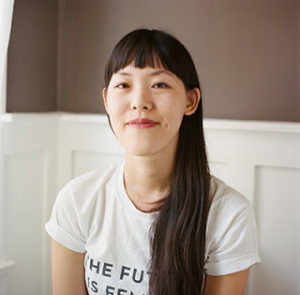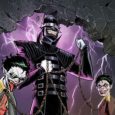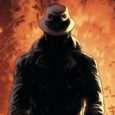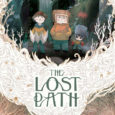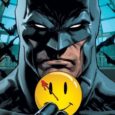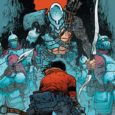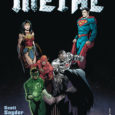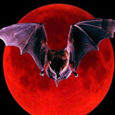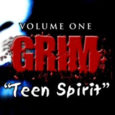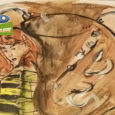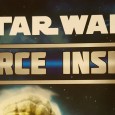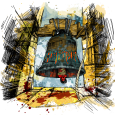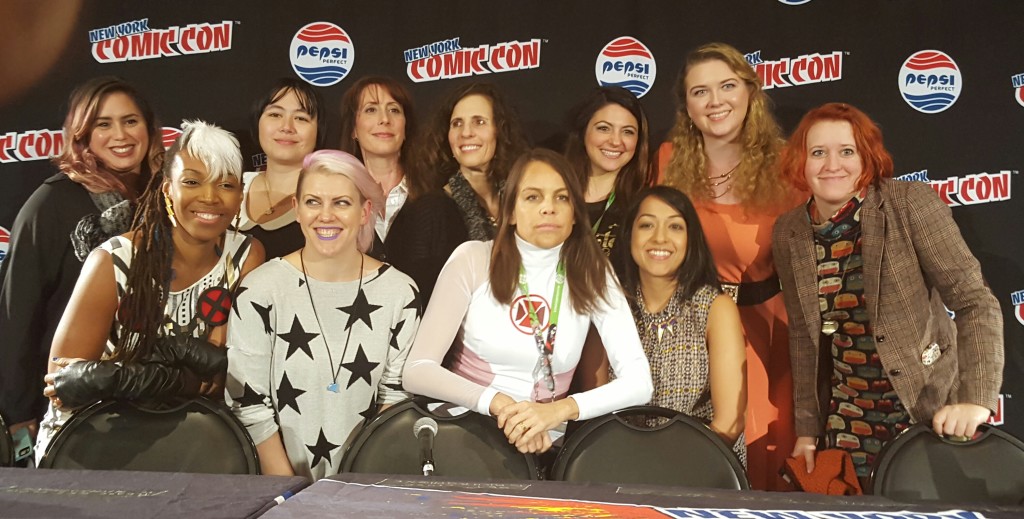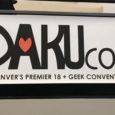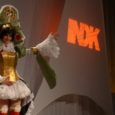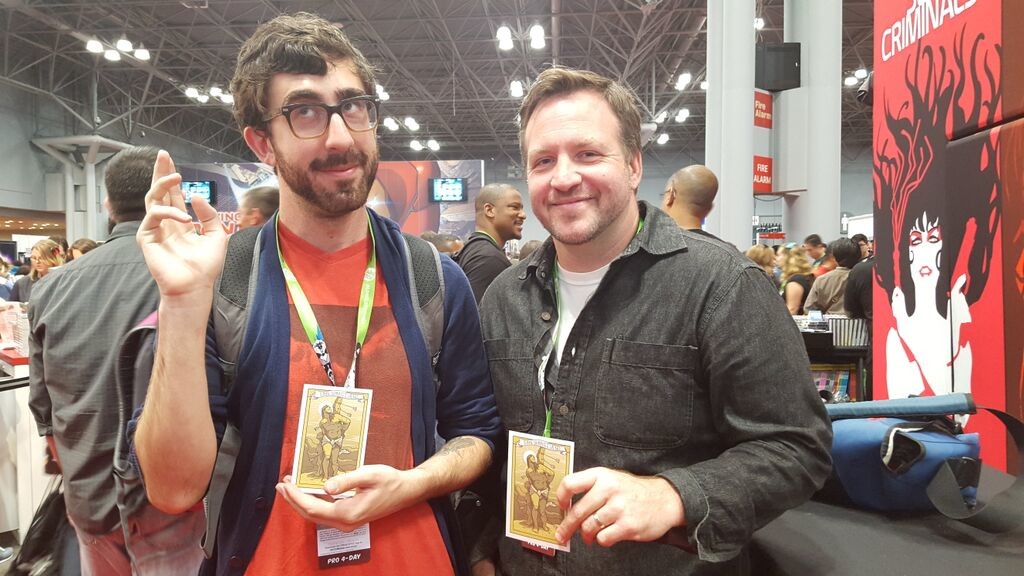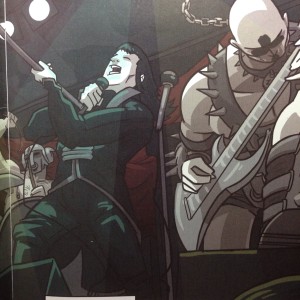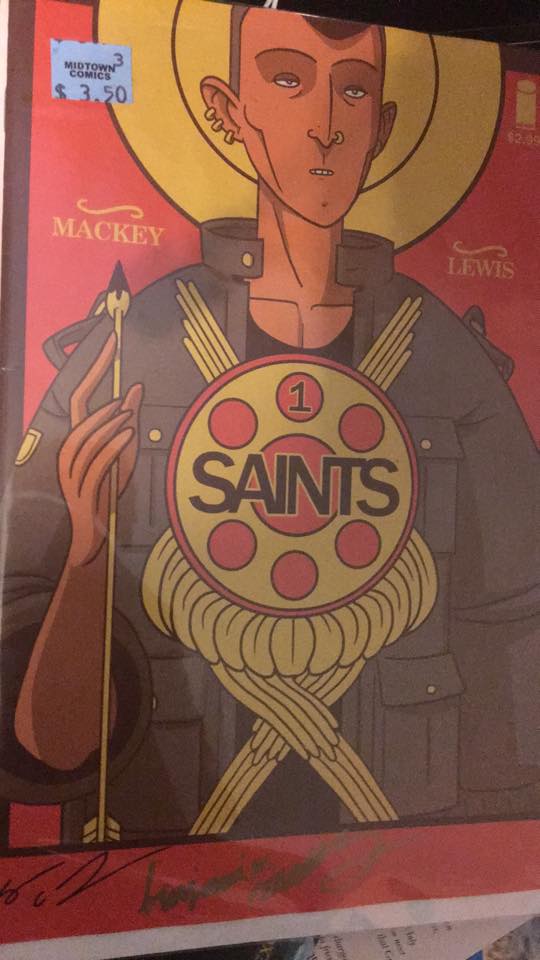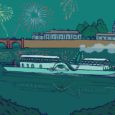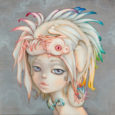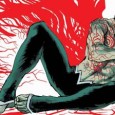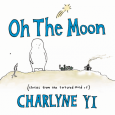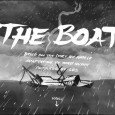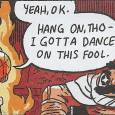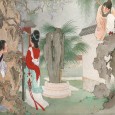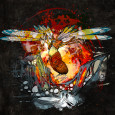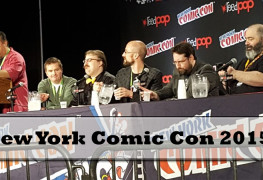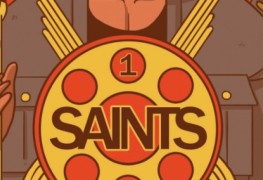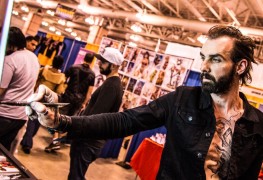Jen Wang is a cartoonist, author and illustrator from Los Angeles and is the creator behind Koko Be Good and co-author of the New York Times Bestselling graphic novel In Real Life with Cory Doctorow. Her latest book, The Prince and the Dressmaker, hit shelves on February 13th, 2018.
The Prince and the Dressmaker revolves around Prince Sebastian as he searches for a bride―or rather, his parents are strong arming him into finding one. However, Sebastian has a secret life: at night he puts on daring dresses and takes Paris by storm as the fabulous Lady Crystallia―the hottest fashion icon in the world capital of fashion!
Sebastian’s secret weapon (and best friend) is the brilliant dressmaker Frances―one of only two people who know the truth: sometimes this boy wears dresses. But Frances dreams of greatness, and being someone’s secret weapon means she has to stay a secret forever. It’s a romantic tale of identity, young love, art, and family.
We met up with Jen after a book signing at Emerald City Comic Con in Seattle.
LC: I wanted to talk a little bit about your protagonist and why you chose to make him exist outside of the heteronormative, cookie cutter, sort of hero. What was your reason for making him fluid?
JW: I think I just felt like…for a while I was looking for a story that would be like a positive Disney movie romantic comedy. Then I wanted to make sure it was a little more contemporary that felt a little queer. I had the idea of a character that would have this clear passion that people could relate to, even if they didn’t have a gender variant identity themselves. If you understand that Sebastian is into fashion and big dresses, that could be something anyone could relate to.
LC: You both wrote and illustrated the book, correct?
JW: Yes!
LC: Was it a conscious decision to make Sebastian unconventionally handsome compared to romcom heartthrobs?
JW: Yeah! I mean, the character is a teenager and I wanted him to look like a teenager. I didn’t want him to be super handsome or too adult looking or too sexy. Not that a teenager can’t be sexy, haha. I wanted to show the version of yourself when you’re still trying to figure out who you are. There’s a lot of recognition in a character who looks like someone you can relate to. I feel like most people seem themselves as conventional looking. The only thing I wanted to make sure to do was to give Sebastian a prominent facial feature . There’s so many costume changes; I didn’t want people to lose the character in a room full of ballgowns.
LC: How did you choose the time period for the book?
JW: The book takes place in the late 19th century and I wanted a time frame that would be sort of old-timey with people in corsets and horse drawn carriages. At the same time, I wanted there to be an emergence of technology. The 19th century had both of those things for me.
LC: Did you pull from any fashion designers as inspiration for your costume designs?
JW: I did research on clothing from the time period. I looked at a lot of historical cosplay costumers online, particularly accessories. There’s a ton of resources for that. The rest I tried to make a bit more modern like something people would wear now.
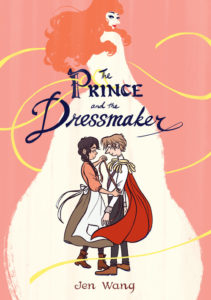 LC: Was it important for you to make the story accessible in every way, versus something that was more queer or adult?
LC: Was it important for you to make the story accessible in every way, versus something that was more queer or adult?
JW: You know, I wanted to make a book that I could read at 13 or 14. It was always the intention, I think. I didn’t really know that much at that age other than what cartoons I liked and what fantasy books I loved.
LC: When you were a teenager, were there any properties that felt accessible to you?
JW: I was really into anime and manga, which I discovered in middle school and high school. I had a friend who was Japanese who had a lot of that stuff. That was before you could find it at the library or in bookstores, haha. It’s actually how I got into comics in general. The thing that was the most influential to me was Revolutionary Girl Utena. I think you can see some overlapping themes in my stuff. It was the first thing I ever read that was queer and unabashedly feminine. I’d never read comics like that before. That was very influential to me.
LC: As someone who also got into comics through manga, I don’t think there was anywhere near the representation you see in that medium as far as the genres of stories you could experience.
JW: There was so much more aimed at teenage girls! I felt completely ignored by American publishers.
LC: I wanted to ask a little about the relationship Sebastian has with his parents. Was that something you drew from real life experiences or just something you wanted Sebastian to go through?
JW: It was something I wanted to have in the book. My parents have always been supportitve of me, but I did ultimately want his parents to accept him despite where they start off. People can change and overlook those prejudices for someone they love.
LC: Is there a comic out that you would like to recommend? Perhaps something recent that might be overlooked?
JW: I really enjoyed Spinning. It reminded so much of how it was like to be a teenager. It felt very real.
—————————————————————————————————
The Prince and the Dressmaker is available wherever graphic novels are sold near you!
Richard Morgan’s ‘A Land Fit for Heroes’ is out now on Mobile with a dizzying plot and grim anti-heroes for those who are ready to embrace all that is dark and violent in the fantasy genre!
Gollancz, an imprint of the Orion Publishing Group, with indie developer Liber Primus Games, today released their joint project – an addictive multiplayer gamebook, the first of its kind, set in the world of award-winning novelist and Crysis 2 and Syndicate writer Richard Morgan’s Sword and Sorcery trilogy A Land Fit for Heroes.
“I am delighted to announce that the ‘Land Fit for Heroes’ gamebook is now out.” said author Richard Morgan, “It’s great to see the world I created for these books come to fresh life in a digital game-book format. I think all fantasy fans are going to appreciate having the power in their hands to choose the destiny of these new characters and to explore the world beyond the limits of the original story.”
A Land Fit for Heroes is a gripping story of three wholly new characters and a sequence of bloodthirsty events steeped in mystery and gore. It is not your average gamebook; A Land Fit for Heroes is darker and deeper than the gamebook norm, explicit in matters of both sex and violence, targeted primarily at a mature audience. The main characters are not traditional heroes but outcasts with scarred souls and murky pasts. This is a story and character design with a truly dark twist; readers may be shocked but they will still be enthralled by Morgan’s rich and mysterious dark fantasy tapestry, presented in a fresh and entirely unique format.
In another first for the gamebook format players will get to choose not only the acts but the sexual orientation of their chosen character, a facet which reflects the diverse character traits and personal choices made by characters in the novels.
This grim fantasy title which represents the first book in the trilogy is now available on the Play Store for Android devices, the App Store for iPhone, iPad, iTouch and additionally on Amazon for Kindle Fire. Steam for Windows PC will launch closer to Christmas in late December. Let us know what you think!
As New York Comic Con gets bigger and bigger, it becomes impossible to take it all in, and no matter how well we plan for it, inevitably things don’t work out. Here is our breakdown of one of the fastest going conventions in the United States.
Thursday goals included attending the 88MPH: A Celebration of Back to the Future, a panel about DC Comics imprint Vertigo’s new #1s, attempting to get into the Viz Media/Musashi Kishimoto panel, and finishing out the day at MootCon4 to talk to people about the Game of Theories webseries. While not an entirely adventurous schedule, the sheer amount of people made it impossible to navigate the exhibit hall (or the smaller, craft/creator filled area called The Block) in a timely manner. New York Comic Con was wall to wall cosplayers in different Doc & Marty costumes (and a TON of Rick & Morty costumes as well), some so well done, several double takes were needed to make sure we didn’t accidentally walk by Christopher Lloyd himself. We had to slowly step our way to the Image booth where we met up with comic creator Ivan Brandon for a scheduled interview, before attempting to make headway toward the Funko booth, hoping to get our eyeballs on some of those exclusives! There were many promotional life-size POP! figures to promote the upcoming Smuggler’s Bounty, and it was difficult to tear ourselves away and re-evaluate our plan as the hour grew late. It was here our paths split, with Tushar checking out the Games and Education panel, Kaitlyn calling it a day, and Leia preparing for a long evening of line waiting to spend an hour in the same room as Naruto creator Masashi Kishimoto, before preparing for day two.
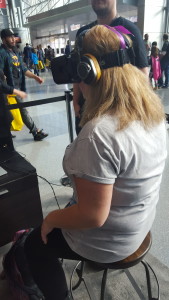 As the weekend progressed, we saw the floors even MORE packed than before and our weary correspondents loaded up their schedule with panels. First, however, Kaitlyn and Leia wandered over to the Audible booth to try out the immersive Locke & Key experience via Oculus Rift, before an interview with Sean Lewis and Benjamin Mackey, newbies in the comic industry. Artist Alley was a sight to behold this year, with greedy fingers reaching for art prints on our way to interview Justin Jordan, and get some stuff signed.
As the weekend progressed, we saw the floors even MORE packed than before and our weary correspondents loaded up their schedule with panels. First, however, Kaitlyn and Leia wandered over to the Audible booth to try out the immersive Locke & Key experience via Oculus Rift, before an interview with Sean Lewis and Benjamin Mackey, newbies in the comic industry. Artist Alley was a sight to behold this year, with greedy fingers reaching for art prints on our way to interview Justin Jordan, and get some stuff signed.
Now despite the name “New York Comic Con,” non-comic media, like television, was there in force too. The folks at Adult Swim were up to their old tricks again with roundtables for Venture Bros, Robot Chicken, and the new miniseries airing soon, Neon Joe, Werewolf Hunter. (You can check out our preview at Adult Swim at NYCC – Neon Joe, Werewolf Hunter). Getting to meet TV personalities like Jon Glaser, Stephanie March, Breckin Meyer and the crazy duo of Doc Hammer and Jackson Publick went exactly as we thought it would go. Antics upon hijinks upon gut busting laughter. It was tough to get through the whole thing without addressing Stephanie March as anything other than “Assistant District Attorney Alexandra Cabot,” but ultimately composure was kept and we found that she, along with the rest of the Adult Swim actor corps, were super cool and friendly people.
TV wasn’t the only non-comic media to make a splash this year. Video games made their presence felt too. If you had (like we did) a bit of trouble getting through the main entrance to the con floor because of a pure sea of concentrated humanity, you were probably going by the Capcom booth. Lining the booth was an army of Street Fighter enthusiasts, and it WAS possible (but not probable) to slither your way in to get a crack at seeing some gameplay from Street Fighter V. The game played faster than its predecessor Street Fighter IV, and you could see some of the classic cast like Karin making their return from the Alpha/Zero series of Street Fighter games. There was a tournament going on as well, so there was always the chance that if you went in to get schooled, it would be public on a lot of large screens.
Square-Enix decided to take the quieter route and had a media suite set up a Shop Studios, just a couple blocks away from the Javits Center. It was nice to get away from the bustle of the con floor for guided demos of their games to small groups of people, and the fact that they fed us definitely did not hurt the experience. Making the rounds through Shop Studios we saw the upcoming Deus Ex: Mankind Divided (check out our preview here), Hitman, Just Cause 3, and the finale to Life Is Strange with Episode 5. The biggest and friendliest surprise though was that Lara Croft: GO wasn’t the only appearance our girl Lara Croft made that day. The full playable demo of Rise of the Tomb Raider looked and played absolutely great.
The Star Wars franchise decided to take an in between approach, setting up their Star Wars Battle Pods outside of the con floor but still inside the Javits Center, making it easy to get to and a beacon of the force as people entered the building. The battle pods let you take command of a few different vehicles from the Star Wars universe, from going on a Death Star bombing run in an X-Wing to trying to hang on for dear life on a speedbike on Endor. Either way, the ride was complete with vibration and pod shakes that one would presumably feel taking your X-wing out of the hangar.
Our last day was spent tying up loose ends, such as taking photos of the creepiest cosplay we could find, picking up more stuff to give away to you guys, and making our last stop at the phenomenal Women of Marvel panel, before shambling off home.
Be sure to check out our other convention coverage and we hope to see you guys in the future! We can’t wait for next year, and leave you with this awesome cosplay video from our friends, SneakyZebra.
In case you haven’t already, don’t forget that we are giving away a bunch of stuff for those of you who didn’t get to attend! Enter below.
Breaking into comics is hard, but publishing your first ever effort at Image, the same home of legends like Robert Kirkman and Jason Aaron, is an accomplishment that may have needed a little divine inspiration. We were incredibly thrilled to be able to talk to the creators of Saints, the brand new book from newcomers to the industry. Writer Sean Lewis and artist Benjamin Mackey proved to us that they were the only team that could have possibly created this book and discuss a newbie’s perspective of the comic industry. Check out the end of the interview to see how you can score a signed copy of Saints #1.
SC: Saints opens back stage at a concert, can you talk a little about the music you both like and how it influences your work?
Ben: For me, I like a lot of bands that deal with religious undertones like Sufjan Stevens or Me Without You. They have these really great pseudo religious narratives where they’re not really clear as to whether or not they have “faith” in their religions. It’s kind of like they’re just constantly questioning things. It’s maybe not so much like there’s a direct influence, but there’s a mentality that this music has of being in this constant state of questioning and pealing back the layers behind religion. That’s something that I like to implement in the book in some way.
Sean: Well I grew up with an uncle who was in a death metal band and we lived in the same house together. I thought he was super cool so I used to go through his record collections all the time. Old school metal has always been something that has been present. I’m also a huge hip hop fan. I usually get drawn to musical styles that have some level of narrative storytelling. A lot of metal has weird Dungeons and Dragons lyrics in it and a lot of the urban lyrics of hip hop music does too. I like a lot of music that changes style and moves around. I listen to a lot of Death Heaven right now and a lot of this rapper named EL-P and Run the Jewels. So things where the dynamic shifts constantly, whether in music or in literature; those are like some of the biggest influences on me. Where you’re watching something where it’s really funny, and then you’re crying, and then it’s dark, and then it’s light. It feels more like life to me, so even the music that I listen to is a lot like that. I would encourage people to get the new Death Heaven; it’s excellent.
SC: My[Kaitlyn] Confirmation name is actually Lucy, which I chose because that is the name of a character in The Chronicles of Narnia. We’re sure that a lot more purposeful decision making went into which saints would be included in your book. Can you talk a little about the research that went into these characters?
Sean: Ha, well my confirmation name is Blaise (the first saint that we meet in the book). The original idea from the book is from Ben. He had been pretty obsessed with the saints.
Ben: So in college I was a painting major and I took a before-1400 art history class, and that got me really interested in western art history, which further solidified into medieval art and early Renaissance history. During those time periods you are just inundated with saints and you can’t escape them because they permeate art for hundreds of years. I studied abroad in Italy for half a year and that was even more full of constant saint exposure. They’ve taken on these iconic super-heroic proportions. I started thinking of about “Oh, what if these saints use their symbols and martyrdoms to inspire their super powers.” So St. Sebastian, for example, was martyred by a hail of arrows, so it became “Oh, what if he can grow these arrows out of his chest and then fire them at people?” Or maybe St. Lucy, because she lost her eyes, maybe she could have this saintly vision and extra-perception that she can tap into.
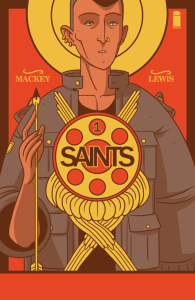 SC: Seems like a logical path of inspiration to us. We should take a moment to congratulate you both on publishing your first issue of your first comic ever! Issue #1 a solid opening for sure. How did you break into the industry?
SC: Seems like a logical path of inspiration to us. We should take a moment to congratulate you both on publishing your first issue of your first comic ever! Issue #1 a solid opening for sure. How did you break into the industry?
Sean: It was kind of crazy and fast. Ben and I only met a year ago and we started talking and this idea came together. Basically we put the book together in about six months and we sent a pdf to Eric Stephenson, the CEO at Image…and he decided to do it.
SC: That’s incredible!
Sean: Ha, I don’t think it’s the typical story. We did a signing with some of the other Image creators the other day who asked how we got in. When I said, “Oh, well we just sent in a pdf,” they were like, “No, seriously, how did you get them to read it?” I don’t know. The timing, I guess, must have been good, but it was very fast. We sent it in, I don’t think expecting-
Ben: It was like our pie-in-the-sky
Sean: Yeah. It was like our reach school for college. You know, we sent off our SATs to reach school and prepared to look at others that we were probably going to be at.
SC: What made you guys choose Image?
Sean: I grew up reading comics but went away for a little bit until I got really obsessed with Jeff Lemire. I read Essex County and that was what brought me back into comics. When I heard that he was writing some books for Image, that brought me over to looking at some of their other work. I started picking up Saga and Southern Bastards. Working on this book, I started reading some more Image books and noticed that they’re doing some really intricate character stories and ours is definitely a weird character story. So then it just seemed like the right fit.
Ben: I didn’t really start reading comics until 6th grade when I started with the typical Marvel and DC books. Then I read Invincible from Robert Kirkman and Ryan Ottley and that totally switched my view of how you can make comics. It was so different and more real than Marvel and DC ones. That led me into all these other Image titles. Image has been one of my favorite comic book publisher every since then.
SC: We definitely think that once people expand their reading beyond what Marvel and DC has to offer, they realize that comics encompasses a huge world with a lot of variety.
Sean: I’m kind of amazed walking around [at NYCC]. I had no idea the breath of independent publishing and how many companies that there are.
SC: Going back to Saints. Will you be incorporating other beliefs and faiths into your story?
Ben: Yeah.
SC: “Yeah” is a perfectly succinct and clear answer.
Sean: Ha, well without going to deeply into it, that’s been a big conversation.
Ben: Even the stranger aspects of Catholic mythology. But we’ll be getting into Zoroastrianism and Gnostic Christianity and occult Christianity.
SC:Have you gotten any backlash from depicting certain aspects of Christianity?
Sean: Well the book only came out two days ago. My grandparents are constantly asking me about it. But in some ways that would be interesting because it would lead to some interesting conversations. Just in the sense, for me at least, religion is this fascinating thing that, whether you are religious or not, is such a huge informant on your life. So many laws and wars that people we know go off and fight are centered around religion. It’s this thing that, whether we want it to be or not, is part of our every day life. I think that there is so much room that if people were to get upset, I’d be like “good, let’s actually talk about it instead of being like ‘Well, I believe it and you don’t’ or ‘I think you’re crazy and you believe in fairy tales so I’m not going to deal with you.'” I’m curious about where you can get those pictures of faiths.
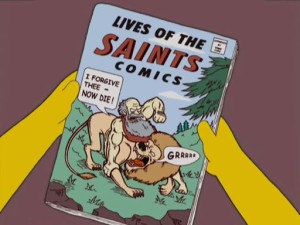 My grandmother is insanely devout and I think sadly thinks that this is going to get taught in Sunday school. Her son is a pretty militant atheist. For me, those are the heavily influences within my house.
My grandmother is insanely devout and I think sadly thinks that this is going to get taught in Sunday school. Her son is a pretty militant atheist. For me, those are the heavily influences within my house.
SC: So this book is Christmas dinner.
Sean: This book is like every Friday night.
SC: Ha, well moving from family dynamics to your working relationship. Do you provide a really strict script to Ben, or does he have free reign to interpret your words?
Sean: Not too strict. I think we’re learning that not a lot of people create the book the way we do. I come from a fiction and playwriting background. So Ben and I break the story down together. So we discuss that “Oh, Sebastian and Lucy will end up here” and then for each issue I go and write like a 3000 word short story, like a really vivid Flannery O’Connor type short story. I send it to Ben and he adapts it into the panels. Then I don’t start writing language or narration until Ben gives me the panels back. It allows us both to really own the world. I get to give him emotionally where I think the scene was or how things were happening and how the characters live and behave, but then I get to see visually where the camera angles are. So I get to really interact with what he’s drawing.
Ben: It’s been great. Having the short story to work with, I get filled with so much more than what a basic script would give me. I’m filled with these emotions and tones that would seem sort of distant in a script. They inform color pallets and how characters would carry themselves and expressions. A lot of the subtle undertones come through by working with the short story that Sean gives me.
Sean: And vice versa. It does two things. A 3000 word short story would be like a really long comic book. So some of the editing naturally happens. The pacing gets better and tighter from what Ben has done. Some of the angles or panel breakdowns help me realize that “Oh, I only need these things” because it’s so much more clear. It’s been a nice give and take on that way of finding the book in that trade.
SC: What about the character designs? Did you collaborate on those?
Sean: We talked about what we thought they would look like.
Ben: We were always on the same boat. I think that we had the same idea about who a character is. I would come with a sketch and Sean would be like “that’s what I was thinking!”
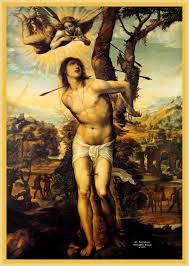 SC: So Sebastian rocking the traditionally “Jesus look” was discussed and premeditated?
SC: So Sebastian rocking the traditionally “Jesus look” was discussed and premeditated?
Ben: Well for Sebastian, his design has a historical precedence. If you look at paintings of St. Sebastian, he looks a lot like that. Over the years he’s turned into this gay icon. That was something that we wanted to reflect in the popular culture that’s been assumed around his precedence and bring that into the comic book world.
SC: Since you are both newcomers to the industry, we’re wondering if you have come across a “club mentality?” Do you feel on the fringe?
Sean: So far people have been really cool. We were just talking about that. Even other companies have been so supportive. The people that we’ve met at Image have been really lovely. To be honest, I haven’t met a ton of other creators yet, but the ones that we have had been really inviting.
I work primarily in theater, which sometimes has a collegiate atmosphere, but there definitely can be some club mentality. I’ve found the comic world a bit more supportive, overall. Just in terms that I’ve been surprised how much other publishers have told us that they hope our book does well.
SC: Leave the competition to DC and Marvel.
Sean: Which seems so smart. There’s been a lot of mentality that, well if you guys do well, we all kind of do well, which is so nice to hear. I’m used to it being like “well, your show is opening against our show, so I hope your show dies.”
SC: As far as the big two are concerned, do you have a dream project that you’d ever do?
Sean: Right now Saints feels like a dream. We met doing a play, so we’d be painting the set while talking about this. So the idea that it went from that to we’re here at Comic Con is insane.
SC: Is this your first convention?
Ben: Oh, yeah.
SC: You guys started big. Have you been able to walk around at all?
Sean: They told us it was big, I didn’t know what that meant I guess. Thursday I was here and able to. Today’s been really overwhelming.
*It should be noted that Ben and Sean were talking to us at the Image booth where Robert Kirkman was doing a signing across from the Marvel stage where, at the same time, the Daredevil cast was trotting out and also next to Viz Media where Naruto dominating the Con . It was the nexus of hell.
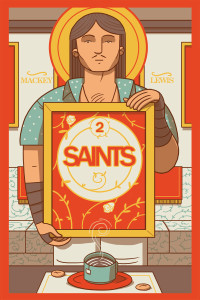
SC: Ok! So tell us about Saints! What can we expect in issues to come?
Ben: I think right now there’s still a lot of world building that we’re doing. We’re starting to see these dreams in the first issue that are cryptic and mysterious. We’re going to see those starting to have more grounding in what’s going on in the plot. You’re gonna see a lot more growing of the characters and interactions with one another and how they relate.
Sean: Plus the growth of the threat. One of the things that you were asking about with faith, you’ll start to see emissaries of other breakdowns of Christianity first. What they want to use the saints for or what they want to do to the saints starts to become really apparent. That’s coming up really soon and heading toward some big face-offs.
SC: We were really interested in your diverse cast. Blaise is half-Irish/half-Mexican and Sebastian is, as you mentioned, a gay icon.
Sean: It’s funny. I was just talking to some people at another booth and they mentioned the same thing. Maybe it’s coming from theater, but it wasn’t really a choice. It just feels like the world to me. You look around Comic Con right now, and that’s all you’re seeing. I’m glad people are responding to that, but I didn’t expect it to be something that would even be a noticeable entity in the book.
SC: Are you familiar with the #lighten up story by colorist Robert Wimberly concerning editorial notes to lighten the skin tone of a mixed-race character? Welcome to the industry, we guess.
Ben: Yes, I read that story.
Sean: So there’s almost like a literal white-washing of characters. In theater, especially, but I guess this is always a conversation. In comics, is there more of a championing for representation and diversity?
SC: Oh, for sure. You’ve entered the industry at a really interesting time. It’s a really good time for a book like Saints to come out.
Ben: I’m just happy because I’m a nerd about saints and that’s like a weird thing to be. I didn’t think anyone was going to like saints as much as I do.
SC: Ha, well that might be true, but I think you’re getting some of us there.
Ben: Ha, well I think Sean has made it more approachable and getting people to nerd-out about saints.
Sean: It’s been helping me deal with Catholic school in a whole different way.
Me too, Sean. Me too.
We want to thank Ben and Sean for taking the time to talk to us and for signing a copy of Saints #1 for us to give away! For a chance to win, follow @SAINTScomic and send them a tweet to let them know @sub-cultured sent you! Saints #2 will be out November 4th.
Kaitlyn D
Content Editor
It’s October, so things are just a little… darker. A little… spookier. A little more creative. And for a quick Artist Spotlight this busy NYCC week, we have just the person to talk to.
CJ Draden, known for his edgy glass paintings of superheroes and live light-box demonstrations has a new debut graphic novel this fall, The Wooden Heart: A Pinocchio Story and new project Atlas he’ll be bringing to this fall/winter convention circuit. We were able to briefly talk to him about his unique craft and a get a glimpse into the story behind his work.
Glass painting is such a unique medium, you certainly don’t hear of too many people doing that. What brought to you to this medium versus other mediums?
CJ: I was traditionally trained in the arts at Ringling College of Art and Design, there I was exposed to traditional media and ways of creating images. What turned me on to glass is somewhat of a philosophical answer. It’s a reflection of myself . There’s a notion of how artists create their work, viewers and artists alike talk about the “feeling” when they see an amazing piece of art or hear a beautiful piece of music. That’s pretty much it.
I wasn’t able to successfully communicate my vision of reality with standard ways of painting and drawing, traditional media. There was this major block from head to hand, everything felt forced. I went back to the drawing board and started building a brand new process and step-by-step kept implementing a technique that felt right. I can say that my journey of building and communicating through my art hasn’t been easy, but if you can visualize… you can manifest. Everything I do is purely based on instinct and not traditional training. I believe that’s the feeling people get when they view my work. Nothing technical, just instinct.
What is it like using this medium for multimedia projects such as for print work for your graphic novel? I’d imagine it’s a bit different.
CJ: I don’t feel art is a matter of trying to fit into a paradigm of projects. It’s more about doing what’s right for you. If it feels right, do it, if it doesn’t feel right, adjust your thought process to make it feel right or project perimeters to make it feel right. When I began writing and illustrating ‘The Wooden Heart,’ I struggled with this because the way I work doesn’t fit the status quo of comics in terms of panels and pages. I was highly critical of myself, and the work I was producing for the book. I had never made a comic or graphic novel before so I didn’t really know what I was doing except that I had a vision for the story and a drive to get it done.
After 4 years of working on it, I was ready to abandon the project. I didn’t feel like it was acceptable. Then I came to understand I needed to apply the same instinct I felt for discovering myself in my glass paintings into finishing ‘The Wooden Heart.’ It’s a major growing pain as an artist, developing the skills to execute to vision you have for creating images and creating stories, but you have to have a vision. If you don’t have a vision then you have no subconscious goal of knowing what you are personally doing that could be better. It’s something that can’t be explained, only felt. Therefore it doesn’t matter how I think my work is going to translate, I have zero control over how people are going to be affected by my work. I’m just a messenger bringing artifacts from a world that exists only to me and placing them in this reality for everyone to see.
Most people are only familiar with Pinocchio as a story from Disney and are unaware the original story is quite a bit more dark and disturbing. What drew you to Pinocchio for adaptation?
CJ: Like all artists, I have experienced my own dark times and struggles. There were probably three primary reasons why I like Pinocchio and decided to write ‘The Wooden Heart.’ The first was that I wanted to deal with my
problems in a way that wasn’t as self destructive as the problems I was struggling to overcome at the time. The second was that I never had a father, but I always loved reading stories about men that lost their mind to the notion that they could create a child to love them unconditionally. A father that wanted a son, like Dr. Frankenstein and Gepetto. The third, I generally don’t talk about. I’ll keep that as a personal story for now.
You’re somewhat of a performer too in a way with your live demonstrations. That’s pretty unique in the comic world. Do you consider yourself a performer?
CJ: Absolutely. I love painting live. I love blues music, and play blues guitar as a hobby. I’m too shy to perform as a musician onstage so I guess I get my shyness out as a performer through my live painting demonstrations at the Comic-Cons.
Can you tell us a little more about “Atlas”?
CJ: Well… there’s a lot to tell about Atlas. But I’ll just say this. I mentioned previously that part of the growing pains of an artist is vision execution. After everything I’ve learned from completing ‘The Wooden Heart’ I started building
projects that reflected the things in life I love to learn about – philosophy, anthropology and science. This project is just the next step in developing my narrative/artistic skills and goals.
Final question! What’s your dream comic? What characters or team would you love to illustrate?
CJ: Sandman. The Endless be my dream team. No pun intended, haha.
Thanks to CJ for letting us ask some questions. For those going to NYCC this week you can catch him at his both, Booth 519 at The Block to check out his work and live demo!
Have you seen any amazing unconventional artists at conventions or online that deserve a single out artist spotlight or feature? Let us know in the comments below or tweet us at @Sub_Cultured and at @maxlikescomics.
Max Eber
Staff Writer
@maxlikescomics
Though a novelist at heart, London born author Richard K. Morgan has quite the resume, having taken a dip into different corners of the writing pool. In addition to writing the story for 2011’s Crysis 2 for noted video game publisher, Electronic Arts, Morgan has also gone a few rounds with Marvel’s spy extraordinaire, Natasha Romanoff, and is currently penning a fantasy trilogy starring a gay protagonist, a surprising rarity within the genre. We hopped on the chance to discuss these things as well as his current project, a digital gamebook of his 2008 fantasy series, A Land Fit For Heroes.
Kimi Britt: At what point did you make the decision that being a writer was something you wanted to do for the rest of your life?
Richard Morgan: Well, early enough that I can’t really remember making it! J K Rowling has a nice way of putting it – she said once in interview that ever since she was old enough to understand that there were people who made their living from writing stories, that was what she wanted to be. Same for me.
KB: Were there any specific works or authors who were some of your early inspirations?
RM: I think there was always a pretty even divide between my SF and Fantasy inspirations and then the stuff you could best designate, I guess, as hardboiled. Growing up, I was a huge fan of Michael Moorcock and Poul Anderson, with a side order of Bob Shaw. But at the same age – rather alarmingly – I was also tearing through Ian Fleming’s Bond and Leslie Charteris’s (original, written in the twenties and thirties) Saint books. Then, in the late seventies, just as I was hitting my teens, I came across William Gibson’s early short stories in Omni magazine and – wow! blam! critical mass! Because, of course, what Gibson had done in those stories was synthesise an alloy of exactly those two genre strands I loved so much – hardboiled noir and the finest speculative SF. I knew instantly that this – this! – was the kind of stuff I wanted to write myself.
KB: What rituals or habits did you adopt when you first started writing, and are they still prevalent in your everyday routine?
RM: Truth is I’m not good at ritual, and the way I write – exploratory, improvised, and painfully slow! – doesn’t lend itself to particularly good working practices. What I did in the early years was just dedicate every available hour of downtime I had to writing, whenever I could and wherever I was. And to be honest, that hasn’t changed all that much even now – it’s just that these days, with no day job to distract me, I have a lot more downtime available, so I get more done!
KB: With novels, comic books, and video games in your repertoire, you’re like a triple threat of the literary world. Was there ever a dramatic difference between these genres during the creation process? Are the three vastly different?
RM: Oh fuck yes – game writing and novel writing are about as far apart as it’s possible to get as creative processes. As a novelist, you’re intensely solitary; you sit in your room and type, you sit in your room and type – usually for a year or more, with no – or at best minimal – feedback until you turn in your draft. Game writing is the exact opposite – it’s intensely collaborative, team-based, fast and modular. You spend a lot of time in meetings, going back and forth to ensure you get a good fit with the other components of the game, and you tend to work in chunks – a cut scene script, a character sketch, a set of situational lines – and you get feedback – good and bad! – on those chunks very fast. You send an item out, get it signed off – or not! – and you’re done with it, so on to the next chunk. Also – this is more an attitudinal thing than a process issue – as a novelist, you know that what you’re writing is the whole thing, whereas in game writing, the work you do is essentially just a support framework for the main gig, which is the gameplay. You could write the finest game storyline ever, the best and sharpest in-game lines in the whole wide world, but if what you’ve done doesn’t gel with the rest, or worse still actually gets in the way of the gameplay, then you’ve failed. That’s a suitably humbling thing for a novelist to take on board.
Comicbook writing, I guess, is something of a midpoint between those two extremes – what you’re doing is the main gig, but it’s a main gig you share with the artist; comparing it with game writing, it’s like the difference between being the bass player in a four or five piece band and being the guitarist in one of those guitar and female vocal duos like the Kills or Mazzy Star. There’s a lot more conscious structuring involved than in novel writing – or at least than in the way I write a novel! – but it’s still largely about uninterrupted flow the way novel work is. If writing a novel is jazz, then writing a comicbook is perhaps more like rock and roll or the blues.
KB: Your sci-fi novel, Altered Carbon, is currently being developed for a movie adaptation. As the author of the source material, how much input do you have on that project?
RM: Generally speaking, when you get a movie deal, you take the money, hand the property over, and that’s about it. It’s rare for a novelist to be involved more deeply than that unless they’ve specifically held out for that involvement contractually, and I never have. My feeling is that when you give your book to someone to turn into the a movie, you need to be comfortable about getting out of the way and letting them work. Sure, you could always jump in and ask to learn the whole exciting process of moviemaking along the way, but is the best place to get that work experience really right bang in the middle of some seasoned film professionals’ attempt to turn your novel into a blockbusting movie? That said, the people I’m dealing with in this case – Laeta Kalogridis and Mythology Entertainment – have been really great about keeping me abreast of the process. And the way the contract is structured – this is something that was offered without my asking for it – once the movie is greenlit, I’m invited to come aboard as creative consultant, which should be a lot of fun.
KB: Some book to movie translations leave fans of the original work less than satisfied with the experience. Are you apprehensive about this prospect or does it feel like a natural progression?
RMl Yeah, there’s really nothing much you can do about that. What fans (and writers!) have to understand is that the movie is not the book, and never can be, it has to change in order to work, to live and breathe in such a radically different medium. What you’re aiming to capture is not the thing itself, but the spirit of the thing. And you’ve got to have faith in the people who’ve taken on the work of making that transformation happen (or at least be sanguine about it, if you’ve sold big for what you suspect will be a pretty crappy product :-) ). Like the old James M Cain quote goes – “People tell me, don’t you care what they’ve done to your book? I tell them, they haven’t done anything to my book. It’s right there on the shelf.”
In my case, I have every faith that the people who are working on Altered Carbon really want to honour the spirit of the novel, and however much my control-freak tendencies might pop and sizzle, I just have to let them get on with the job.
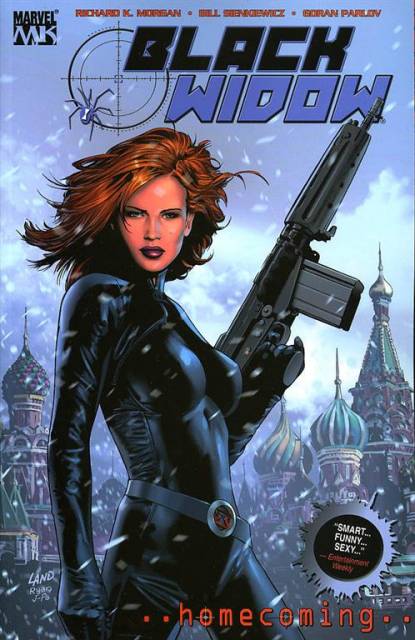 KB: With the influence you had on Black Widow’s characterization and how well the Avengers is doing, do you feel like she is accurately portrayed?
KB: With the influence you had on Black Widow’s characterization and how well the Avengers is doing, do you feel like she is accurately portrayed?
RM: Absolutely not, but what can you expect? I’ve said this before at length to Charlie Jane Anders over at Io9 – the Widow exists as an adjunct of a money-spinning superhero franchise catering to the tastes of 12 to 14 year old boys (and men who’ve somehow managed to grow up and retain a 12 to 14 year old boy heart). As such, she’s the epitome of unthreatening femininity grafted onto a pornstar’s T&A chassis and imbued with a set of plug-and-play boy-hero fisticuff character tics and reflexes. There’s nothing in that for women, nothing much in it even for genuinely grown-up males. The Widow I wrote for Marvel back in the early 2000s was her own woman, older, seasoned, hard as nails and unapologetic about it, centre stage in her own story. And let me tell you, that story flew like a fucking brick – the broad Marvel fanbase hated it. They didn’t like this genuinely empowered (and therefore genuinely feminist) female protagonist, and they voted with their wallets. The arc did disastrously low numbers by Marvel standards. So am I surprised by the version of the Widow that’s now emerged in the movies – hell, no! Just immensely saddened.
KB: Given the chance, would you ever want to return to continue her story?
RM: Are you fucking kidding! I’d love to. Writing Natasha, really letting her breathe, was a total blast! I’d jump at the chance to build a movie around her that did the same things Homecoming did. But there’s no way that’s ever going to happen. Don’t get me wrong, Marvel were great to work for; very professional, very supportive of what I was trying to do, and they really went out on a limb by letting me run with the character for a second arc when the first one had sold so dismally. But in the end, they killed the series for one very simple reason; it was a losing proposition – an expensive auteur project (I mean, we had Bill Sienkiewicz aboard, for Christ’s sake!), and doing dismally downward-spiralling numbers. By contrast, the version of the Widow you see in the movies is pulling in tens of millions of fanboy dollars. I mean, do the math – there’s just no way anyone’s going to let me within a mile of Natasha ever again! :-)
KB: Since you’ve had experience writing for both readers and gamers separately, the idea of bringing your dark fantasy series A Land Fit For Heroes to Steam, iOS, and Android as a gamebook is definitely intriguing to someone who enjoys both. How will a digital gamebook differ from the more traditional “Choose Your Own Adventure” type stories currently available? CYOA stories are typically made for a younger crowd, yet your series offers plenty of mature and controversial themes. Will these remain, and if so, how will they engage the player and the choices they make?
RM: That’s a question I’m not really qualified to answer – I never read the CYOA books back in the day, and I haven’t accessed any of the newer content either (these days I’m so busy I barely have time to read books or play games of any sort, let alone explore whole new formats!)
But my understanding from the brief the guys at Liber Primus have given me is that the vast majority of this stuff is YA-level in content. Land Fit for Heroes is avowedly not – it’s very much an adult fantasy, with adult themes and characters, and it’s as grim as anything I’ve ever written, which is saying something. So there’s that. :-)
 KB: How closely will the gamebook follow the existing story? Do players who have previously read the original have an advantage over newcomers to the series?
KB: How closely will the gamebook follow the existing story? Do players who have previously read the original have an advantage over newcomers to the series?
RM: The story in the gamebooks runs parallel to the main narrative in the novels – there’s some faint crossover with my characters in that some of them will make brief cameo appearances in the gamebook story, but the narrative thread itself follows three entirely new characters, and their adventures are disconnected from the storylines in the trilogy – though what they do and go through will be shown to have influence on the overall turn of events detailed in the novels. What this means for readers who’ve never read my stuff is that they’ll get a different initial angle of entry into my universe; but that won’t disadvantage them in any way as far as the gamebook story is concerned. And of course, if they’re curious about the wider world of the fiction, they can always go off and buy the trilogy after.
KB: What other projects are you currently working on?
RM: I’ve got a new novel up on the blocks at the moment – it’s a return to the universe of my 2007 novel Black Man, but set a good hundred or more years after the events of that story, and on a recently colonised Mars rather than on Earth. It’s called Thin Air and features another genetically modified cast-off protagonist, though a somewhat different and more down-at-heel one than Carl Marsalis in Black Man. I’ve gone right back to the noir wellspring I used in my Takeshi Kovacs books with this one – first person narrative, mean streets, corruption from high to low, a crime no-one wants solved and enemies at every turn. Feels good to be back behind the wheel of one of these!
KB: What sorts of media are you consuming in your spare time and would recommend?
RM: Not a whole lot of spare time to burn right now, I just moved from one end of the country to the other and I’m snowed under with busted deadlines. I am listening to quite a lot of music while I work, though; currently bingeing on 2 Cellos, Health and Cold Specks. And I just discovered an up-and-coming singer song-writer called Isaac Gracie whose single Last Words would make an awesome playout for a movie of my novel Market Forces. I just finished reading Ta-Nehisi Coates’ Between the World and Me, which I’d say is required reading for anyone interested in what’s happening to America at the moment and made me tremble with a father’s rage, and I’m now burning through John Horner Jacobs’ The Incorruptibles which is a superbly fresh-feeling mash-up of fantasy, alternate history and western adventure, the first of a trilogy whose second instalment, Foreign Devils, just came out – I’m running to catch up here! I’ve also been catching up on missed SF movies like Chappie and Ex Machina (both of which I guess I’d recommend seeing but neither of which in the end quite lit my fire) and more noirish fare like Scott Cooper’s Out of the Furnace and Dennis Lehane’s The Drop (both of which are awesome must-see triumphs). Still, sadly, waiting for someone in SF movie making – well, apart from George Miller, that is – to combine the vision and imagination in the former two with the close focus grit and commitment to human realities of the latter. In gaming, I’ve been making do with obsessive replays of The Last of Us, Max Payne 3 and Far Cry until there are enough good games out there to justify the expense of acquiring a next-gen console. At which point, I imagine I’ll be trying Bloodborne.
KB: Finally, where can you be found in various corners of the Internet?
RM: I keep a website at richardkmorgan.com where I try to find time and inspiration to blog at least once a month, and I’m on Twitter as @quellist1. Come on over!
Richard K. Morgan is the acclaimed author of The Dark Defiles, The Cold Commands, The Steel Remains, and Altered Carbon, a New York Times Notable Book that won the Philip K. Dick Award in 2003. A Land Fit For Heroes will be available on Android and ioS, as well as a PC version of the gamebook for Steam in the coming months.


